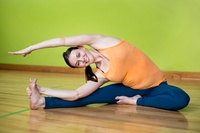GROUPON GUIDE TO DENVER
Asana? Ujjayi? All the Yoga Terms You Should Know Before Your First Class
BY: Editors |Jan 30, 2019
BY:
Yoga Classes Near You

Explore Hypnosis Audios for Weight Loss and Smoking Liberation
Sale Ends 4/27
$12.96 with_code GROUPON
Hypno-Trance Zone

3, 6 or 12-Months of Unlimited Online Meditation
$9$8.10
Sale Ends 4/27
$7.29 with_code GROUPON
Unlimited Online Meditation

Up to 62% Off on Online Yoga / Meditation Course at Yoga CEU Courses - Online
Sale Ends 4/27
$7.29 with_code GROUPON
40+ bought
Yoga CEU Courses - Online

Explore Mindfulness with Our Meditation Online Course
Sale Ends 4/27
$8.10 with_code GROUPON
Training Express

Yoga, Energy, and Mindfulness Services for Relaxation
2550 Youngfield Street, Lakewood • 11.9 mi
Sale Ends 4/27
$52.65 with_code GROUPON
2 bought
South Table Wellness

Online Yoga Course at Pretzel Kids
Sale Ends 4/27
$40.50 with_code GROUPON
8 bought
Pretzel Kids
More Yoga DealsOther Deals in denver

Trending
Experience 2 Weeks Unlimited Kaiut Yoga for All Levels
4800 Baseline Road, Boulder • 9.5 mi
Sale Ends 4/27
$34.02 with_code GROUPON
Kaiut Yoga Boulder

Trending
Revolutionize Your Fitness Routine: Ten Days or Three Class Pack!
7735 West Long Drive, Littleton • 21.4 mi
83% discount_off
$8 with_code GROUPON
SPENGA

Up to 10% Off Yoga Classes at YogaSix Northfield
8216 Northfield Boulevard, Denver • 14.1 mi
Sale Ends 4/27
$21.06 with_code GROUPON
YogaSix Northfield

Crush Your Fitness Goals with 90-Days of Premium Workouts
Sale Ends 4/27
$4.05 with_code GROUPON
Daily Burn

Up to 92% Off Online Yoga Subscriptions with Unlimited Classes
89% discount_off
$4 with_code GROUPON
The Yoga Collective

Experience Balance with 2 Week Unlimited Yoga-Barre
3241 Lowell Boulevard, Denver • 11.3 mi
Sale Ends 4/27
$39.69 with_code GROUPON
Barre3

Up to 78% Off Online Classes from Yoga Download
Sale Ends 4/27
$12.95 with_code GROUPON
YogaDownload.com

Unlimited Online Yin & Restorative Yoga Memberships
Sale Ends 4/27
$7.29 with_code GROUPON
Unlimited Online Yin & Restorative Yoga

98% Off Mindfulness, Meditation and Manifestation Courses
Sale Ends 4/27
$4.05 with_code GROUPON
SkillSuccess eLearning

Yoga For Beginners Masterclass: 15 Fundamental Sessions
Sale Ends 4/27
$8.10 with_code GROUPON
SkillSuccess eLearning

Up to 70% Off on Online Chakra Healing & Meditation Course at peaceinside.me
Sale Ends 4/27
$10.53 with_code GROUPON
peaceinside.me

Up to 54% Off on Yoga Class at Studio Bamboo Institute of Yoga
2861 Lynnhaven Drive, Virginia Beach
Sale Ends 4/27
$49.01 with_code GROUPON
Studio Bamboo Institute of Yoga

Up to 86% Off on Online Yoga / Meditation Course
Sale Ends 4/27
$3.24 with_code GROUPON
Semaglutide LLC

Up to 49% Off on Yoga - Aerial at PYT FITNESS
12201 E Arapahoe Rd, Denver • 25.9 mi
Sale Ends 4/27
$20.25 with_code GROUPON
PYT FITNESS

Unlimited On-Demand Yoga and Barre Classes Online Access
Sale Ends 4/27
$9.72 with_code GROUPON
20+ bought
Body Alive





